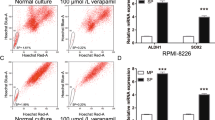Abstract
Multiple myeloma (MM) remains fatal despite all available therapies. Initial treatment with conventional drugs such as, Dexamethasone (Dex) effectively induces MM cell death; however, prolonged drug exposures results in the development of chemoresistance. Our prior study demonstrated that 2-Methoxyestradiol (2ME2) induces apoptosis in multiple myeloma (MM) cells resistant to Dexamethasone (Dex). Here, we show the mechanism whereby 2ME2 overcomes Dex-resistance. The oligonucleotide array analysis demonstrates that Heat Shock Protein–27 (Hsp27) is upregulated in Dex-resistant, but not in Dex-sensitive MM cells. Proteomics analysis of Hsp27-immunocomplexes revealed the presence of actin in Dex-resistant, but not in Dex-sensitive cells. Biochemical interaction between Hsp27 and actin was examined by co-immunoprecipitation with anti-Hsp27 or actin Abs. Far western blot analysis using GST-Hsp27 fusion protein showed a direct association with actin both in vitro and in vivo. Importantly, 2ME2- or Bortezomib/Proteasome inhibitor (PS-341)-induced apoptosis in Dex-resistant MM cell lines and MM patient cells is associated with disruption of the Hsp27-actin complexes. Finally, blockade of Hsp27 by anti-sense strategy enhanced anti-MM activity of both 2ME2 and PS-341. These findings provide the clinical application of novel therapeutics targeting Hsp27 to improve patient outcome in MM.
Similar content being viewed by others
References
Willie AH, Kerr JF, Currie AR. Cell death: The significance of apoptosis. Int Rev Cytol 1980; 68: 251-306.
Anderson KC. Moving disease biology from the lab to the clinic. Cancer 2003; 97: 796-801.
Alexanian R, Dimopoulos MA, Delasalle K, Barlogie B. Primary dexamethasone treatment of multiple myeloma. Blood 1992; 80: 887-890.
Anderson KC. Moving disease biology from the laboratory to the clinic. Semin Oncol 2002; 29: 17-20.
Greenstein S, Ghias K, Krett NL, Rosen ST. Mechanisms of glucocorticoid-mediated apoptosis in hematological malignancies. Clin Cancer Res 2002; 8: 1681-1694.
Concannon CG, Gorman AM, Samali A. On the role of Hsp27 in regulating apoptosis. Apoptosis 2003; 8: 61-70.
De AK, Kodys KM, Yeh BS, Miller-Graziano C. Exaggerated human monocyte IL-10 concomitant to minimal TNF-alpha induction by heat-shock protein 27 (Hsp27) suggests Hsp27 is primarily an antiinflammatory stimulus. J Immunol 2000; 165: 3951-3958.
Mehlen P, Kretz-Remy C, Briolay J, Fostan P, Mirault ME, Arrigo A-P. Intracellular reactive oxygen species as apparent modulators of heat-shock protein 27 (hsp27) structural organization and phosphorylation in basal and tumour necrosis factor alpha-treated T47D human carcinoma cells. Biochem J 1995; 312: 367-375.
Huot J, Houle F, Marceau F, Landry J. Oxidative stress-induced actin reorganization mediated by the p38 mitogen-activated protein kinase/heat shock protein 27 pathway in vascular endothelial cells. Circ Res 1997; 80: 383-392.
Kozawa O, Niwa M, Hatakeyama D, et al. Specific induction of heat shock protein 27 by glucocorticoid in osteoblasts. J Cell Biochem 2002; 86: 357-364.
Ito H, Kamei K, Iwamoto I, et al. Inhibition of proteasomes induces accumulation, phosphorylation, and recruitment of HSP27 and alphaB-crystallin to aggresomes. J Biochem (Tokyo) 2002; 131: 593-603.
Arrigo A-P, Suhan JP, Welch WJ. Dynamic changes in the structure and intracellular locale of the mammalian lowmolecular-weight heat shock protein. Mol Cell Biol 1988; 8: 5059-5071.
Mehlen P, Arrigo A-P. The serum-induced phosphorylation of mammalian hsp27 correlates with changes in its intracellular localization and levels of oligomerization. Eur J Biochem 1994; 221: 327-334.
Moalli PA, Pillay S, Weiner D, Leikin R, Rosen ST. A mechnism of resistance to glucocorticoids in multiple myeloma: Transient expression of a truncated glucocortiocoid receptor mRNA. Blood 1992; 79: 213-222.
Chauhan D, Catley L, Hideshima T, et al. 2-Methoxyestradiol overcomes drug resistance in multiple myeloma cells. Blood 2002; 100: 2187-2194.
Li C, Wong WH. Model-based analysis of oligonucleotide arrays: Expression index computation and outlier detection. Proc Natl Acad Sci USA 2001; 98: 31-36.
Chauhan D, Kharbanda SM, Rubin E, et al. Regulation of cjun gene expression in human T lymphocytes. Blood 1993; 81: 1540-1548.
Hideshima T, Chauhan D, Shima Y. Thalidomide and its analogs overcome drug resistance of human multiple myeloma cells to conventional therapy. Blood 2000; 96: 2943-2950.
Chauhan D, Kharbanda SM, Ogata A. OncostatinMinduces association of Grb2 with Janus kinase JAK2 in multiple myeloma cells. J Exp Med 1995; 182: 1801-1806.
Chauhan D, Auclair D, Robinson EK, et al. Identification of genes regulated by dexamethasone in multiple myeloma cells using oligonucleotide arrays. Oncogene 2002; 21: 1346-1358.
Chauhan D, Li G, Hideshima T, et al. Hsp27 inhibits release of mitochondrial protein Smac in multiple myeloma cells and confers dexamethasone resistance. Blood 2003; 102: 3379-3386.
Lavoie JN, Lambert H, Hickey E, Weber LA, Landry J. Modulation of cellular thermoresistance and actin filament stability accompanies phosphorylation-induced changes in the oligomeric structure of heat shock protein 27. Mol Cell Biol 1995; 15: 505-516.
Yamamoto K, Okamoto A, Isonishi S, Ochiai K, Ohtake Y. Heat shock protein 27 was up-regulated in cisplatin resistant human ovarian tumor cell line and associated with the cisplatin resistance. Cancer Lett 2001; 168: 173-181.
Paul C, Manero F, Gonin S, Kretz-Remy C, Virot S, Arrigo AP. Hsp27 as a negative regulator of cytochrome C release. Mol Cell Biol 2002; 22: 816-834.
Garrido C, Bruey JM, Fromentin A, Hammann A, Arrigo AP, Solary E. HSP27 inhibits cytochrome c-dependent activation of procaspase-9. Faseb J 1999; 13: 2061-2070.
Bruey JM, Ducasse C, Bonniaud P, et al. Hsp27 negatively regulates cell death by interacting with cytochrome c. Nat Cell Biol 2000; 2: 645-652.
Author information
Authors and Affiliations
Corresponding author
Rights and permissions
About this article
Cite this article
Chauhan, D., Li, G., Auclair, D. et al. 2-Methoxyestardiol and bortezomib/proteasome-inhibitor overcome dexamethasone-resistance in multiple myeloma cells by modulating Heat Shock Protein-27. Apoptosis 9, 149–155 (2004). https://doi.org/10.1023/B:APPT.0000018797.66067.6c
Issue Date:
DOI: https://doi.org/10.1023/B:APPT.0000018797.66067.6c




